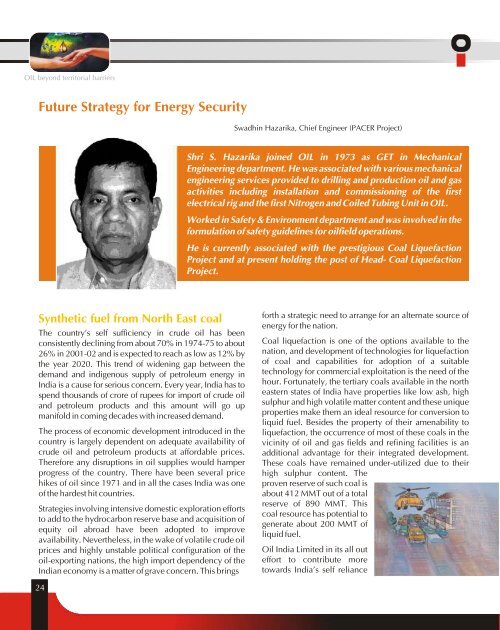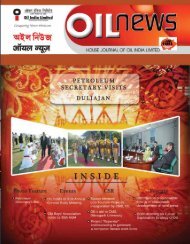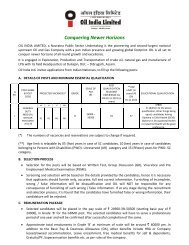2005 - Oil India Limited
2005 - Oil India Limited
2005 - Oil India Limited
Create successful ePaper yourself
Turn your PDF publications into a flip-book with our unique Google optimized e-Paper software.
OIL beyond territorial barriers<br />
Future Strategy for Energy Security<br />
Swadhin Hazarika, Chief Engineer (PACER Project)<br />
Shri S. Hazarika joined OIL in 1973 as GET in Mechanical<br />
Engineering department. He was associated with various mechanical<br />
engineering services provided to drilling and production oil and gas<br />
activities including installation and commissioning of the first<br />
electrical rig and the first Nitrogen and Coiled Tubing Unit in OIL.<br />
Worked in Safety & Environment department and was involved in the<br />
formulation of safety guidelines for oilfield operations.<br />
He is currently associated with the prestigious Coal Liquefaction<br />
Project and at present holding the post of Head- Coal Liquefaction<br />
Project.<br />
Synthetic fuel from North East coal<br />
The country's self sufficiency in crude oil has been<br />
consistently declining from about 70% in 1974-75 to about<br />
26% in 2001-02 and is expected to reach as low as 12% by<br />
the year 2020. This trend of widening gap between the<br />
demand and indigenous supply of petroleum energy in<br />
<strong>India</strong> is a cause for serious concern. Every year, <strong>India</strong> has to<br />
spend thousands of crore of rupees for import of crude oil<br />
and petroleum products and this amount will go up<br />
manifold in coming decades with increased demand.<br />
The process of economic development introduced in the<br />
country is largely dependent on adequate availability of<br />
crude oil and petroleum products at affordable prices.<br />
Therefore any disruptions in oil supplies would hamper<br />
progress of the country. There have been several price<br />
hikes of oil since 1971 and in all the cases <strong>India</strong> was one<br />
of the hardest hit countries.<br />
Strategies involving intensive domestic exploration efforts<br />
to add to the hydrocarbon reserve base and acquisition of<br />
equity oil abroad have been adopted to improve<br />
availability. Nevertheless, in the wake of volatile crude oil<br />
prices and highly unstable political configuration of the<br />
oil-exporting nations, the high import dependency of the<br />
<strong>India</strong>n economy is a matter of grave concern. This brings<br />
forth a strategic need to arrange for an alternate source of<br />
energy for the nation.<br />
Coal liquefaction is one of the options available to the<br />
nation, and development of technologies for liquefaction<br />
of coal and capabilities for adoption of a suitable<br />
technology for commercial exploitation is the need of the<br />
hour. Fortunately, the tertiary coals available in the north<br />
eastern states of <strong>India</strong> have properties like low ash, high<br />
sulphur and high volatile matter content and these unique<br />
properties make them an ideal resource for conversion to<br />
liquid fuel. Besides the property of their amenability to<br />
liquefaction, the occurrence of most of these coals in the<br />
vicinity of oil and gas fields and refining facilities is an<br />
additional advantage for their integrated development.<br />
These coals have remained under-utilized due to their<br />
high sulphur content. The<br />
proven reserve of such coal is<br />
about 412 MMT out of a total<br />
reserve of 890 MMT. This<br />
coal resource has potential to<br />
generate about 200 MMT of<br />
liquid fuel.<br />
<strong>Oil</strong> <strong>India</strong> <strong>Limited</strong> in its all out<br />
effort to contribute more<br />
towards <strong>India</strong>'s self reliance<br />
24

















